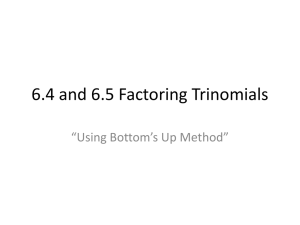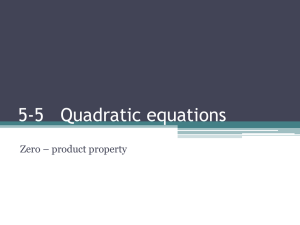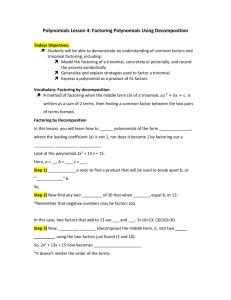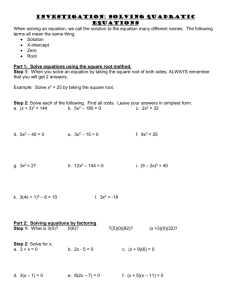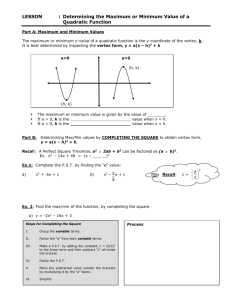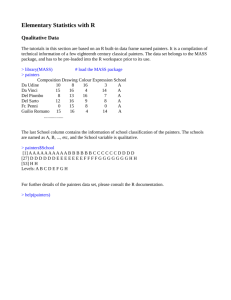Polynomials Using the Distributive Property 3m2n(2m2 - 7mn
advertisement
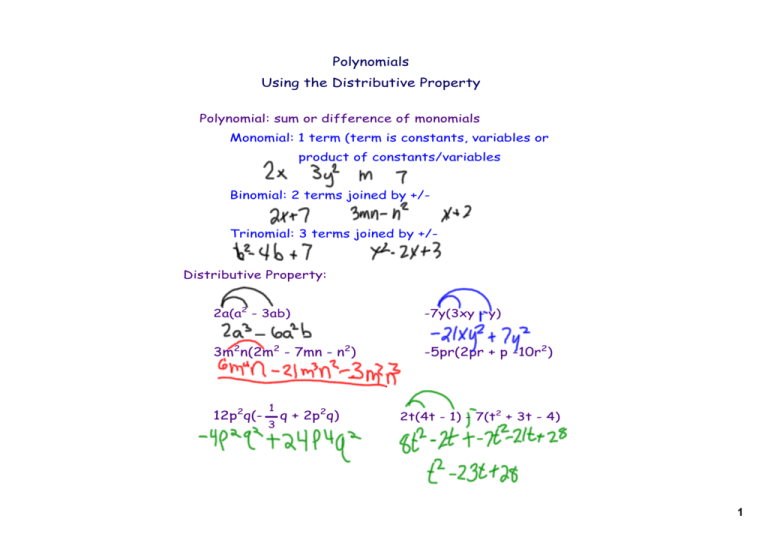
Polynomials Using the Distributive Property Polynomial: sum or difference of monomials Monomial: 1 term (term is constants, variables or product of constants/variables Binomial: 2 terms joined by +/Trinomial: 3 terms joined by +/- Distributive Property: 2a(a2 - 3ab) -7y(3xy - y) 3m2n(2m2 - 7mn - n2) -5pr(2pr + p -10r2) 12p2q(- 1 3 q + 2p2q) 2t(4t - 1) - 7(t2 + 3t - 4) 1 Adding and Subtracting Polynomials Multiply if necessary Combine like terms (5x3 - x + 2x2 + 7) + (3x2 + 7 - 4x) + (4x2 - 8 - x3) Horizontal Method Vertical Method (-2x3 - x + 5x2 + 8) - (-2x3 + 3x - 4) Horizontal Method Vertical Method (3x2 - 5x + 3) - 2x(-2x - 3) - 4 FOILING FOILING Multiplying 2 binomials (x - 2)(x + 3) F (first) O (outer) I (inner) L (last) x x = x2 x 3 = 3x x2 + 3x + -2 x = -2x -2 3 = -6 -2x + -6 x2 + x - 6 (x - 1)(x - 6) F F O I (2m + 1)(m - 5) L (3t + 5)(t + 3) O I L F F O I L (y - 4)(y + 4) O I L 2 Special Products Crossing 2 pink snapdragons Pink snapdragons are half red, half white (.5R + .5W) Crossing 2 pink = (.5R + .5W)(.5R + .5W) or = (.5R + .5W)2 R W (.5R + .5W)(.5R + .5W) R W Perfect Square Trinomials: (a + b)2 Try: (x + 2)2 (2m + 1)2 (a - b)2 Try: (x - 3)2 (2m - 1)2 Difference of perfect squares: (a + b)(a - b) Try: (x + 2)(x - 2) (2m + 1)(2m - 1) (x + 5)(x - 5) (n - 3)(n + 3) 3 Zero Product Property if ab = 0, then a =0, b = 0 or a & b = 0 Examples: (x - 2)(x + 3) = 0 (2x + 1)(3x - 2) = 0 (x - 4)(x + 5) = 0 When y = 0, you get the x-intercepts of a trinomial, a.k.a._______________________ or ______________________ Find the vertex the old-fashioned way, and graph, using the vertex and roots y = (x - 4)(x + 1) y = (x - 4)(x + 4) 4 1. y = (2x - 4)(x - 2) 3. y = (2x - 2)(x + 4) 5. y = 2x2 + 16x + 30 2. y = 2x2 - 6x - 8 4. y = (-x - 3)(x - 4) 6. y = (-x - 6)(x - 6) 5 Factoring Factoring Out Monomials "undistribute" the GCF makes factoring trinomials easier 5n - n2 24x + 48y 12x3y2 - 18x2y2 + 30x Factoring Trinomials Find the numbers that add to equal "b" and multiply to equal "c" factors x2 + 7x + 12 m2 - 14m + 40 y2 - 5y - 24 -a2 + 16a + 36 Factoring with a leading coefficient (trial and error): 3x2 + 2x - 8 7a2 + 22a + 3 2x2 - 5x - 12 3c2 - 3c - 5 4n2 - 4n - 35 6m2 + 19mn + 10m2 -4y2 + 19y - 21 Factoring the difference of perfect squares n2 - 25 4y2 - 169 8m2 - 242 196x2 - 16y2 6 7 INVERSE VARIATION Remember Direct Variation - graph was a ________________ - as x _____________, y _________________ - equation looked like: ________________ - "k" was the ______________ ___ _____________ Inverse variation: As x increases, y decreases (like negative correlation) at a constant rate, "k" the inv variation equation is y = k x the formula for k = xy Example: When you walk, time is inversely related to speed (if you take a 5mile walk, the faster you walk, the less time it takes) Area covered by a truckload of mulch and the depth of the mulch Time it takes to paint a house and the # of painters (2 painters take 6 hours 3 painters take 4 hours 4 painters take 3 hours...) The equation for the relationship is: y = 12 x Where y = # of hours and x = # painters (the constant of variation (k) = xy or 6hrs x 2 painters 4 hrs x 3 painters 3 hrs x 4 painters find the equation if x & y vary inversely: x = 2, y = 5 x = 13/5, y = 5 x = 3, y = 7 If the volume of a prism (vol = Bh)= 10m3, the base and height are inversely related. What is "k"? What is the equation that relates x to y? What is the measure of the base when the height = 4m? 8 Graphing Quadratics by Factoring 1 2 3 Find the vertex Set the trinomial equal to zero to find the x-intercepts factor the trinomial into 2 linear factors use zero product property to solve for zeros Graph the vertex and intercepts/zeros y = 10x2 - 7x - 12 y = x2 - 3x - 18 y = x2 - 6x + 9 Spe cial Cas e! 9
